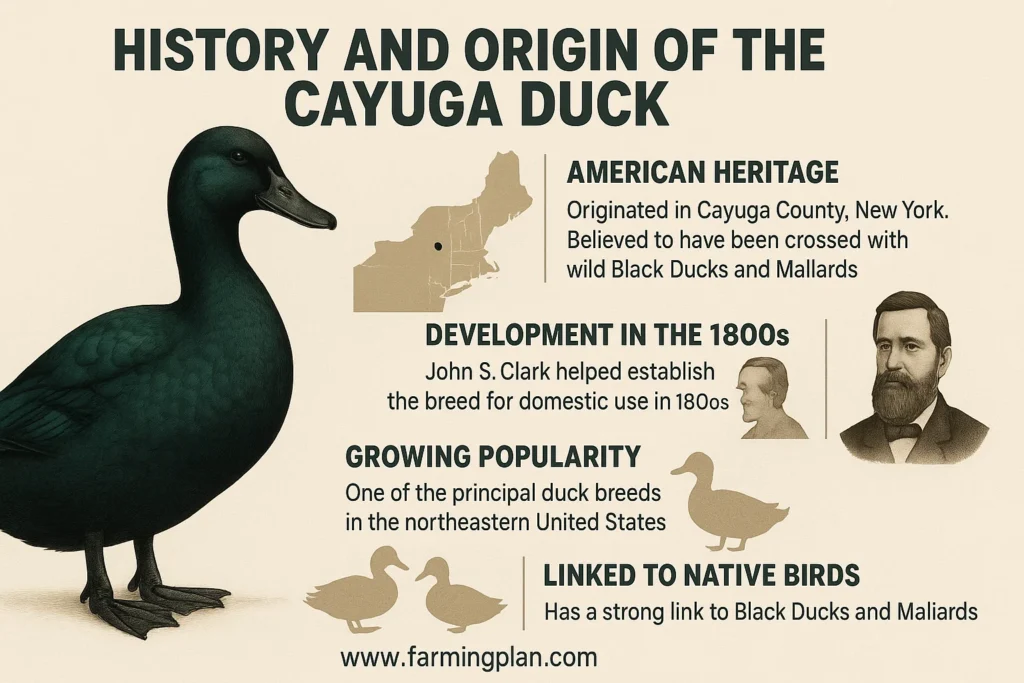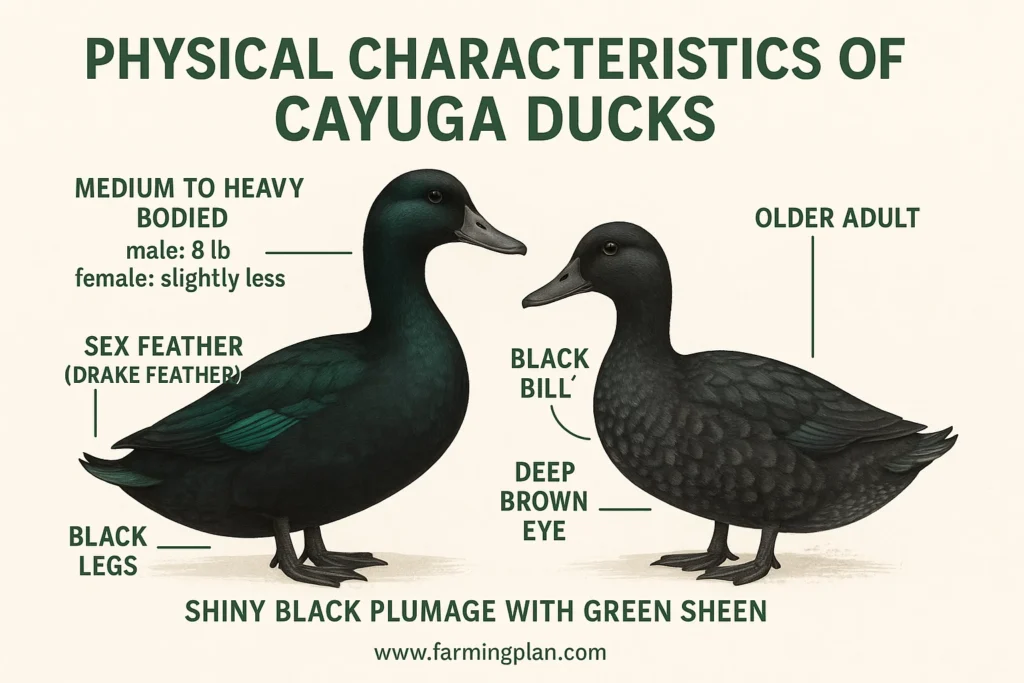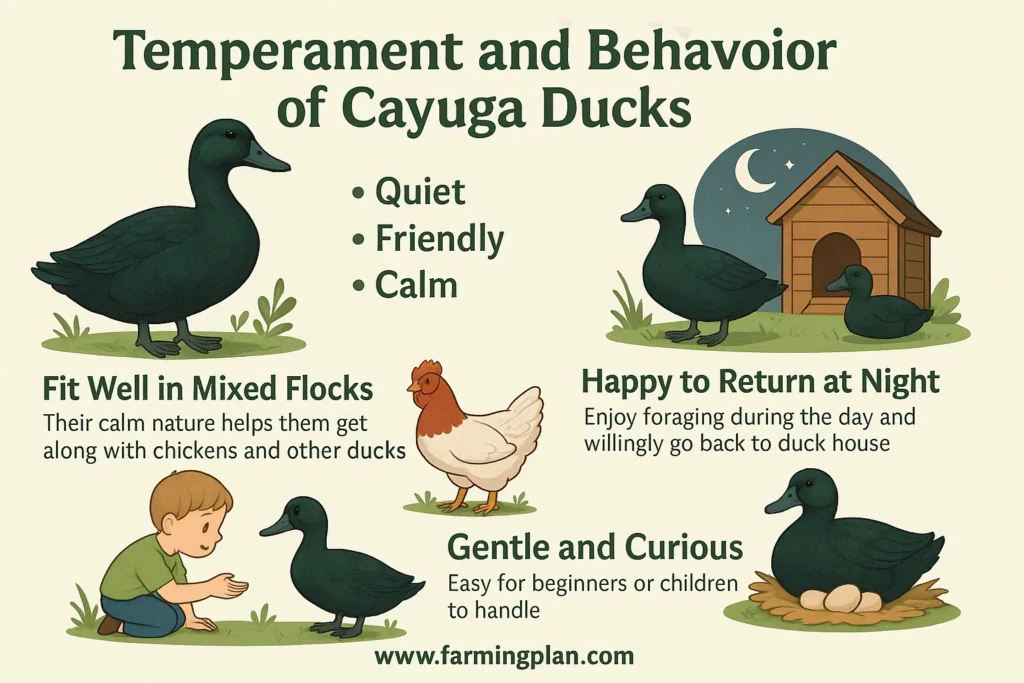The Cayuga duck is one of the most beautiful and unique duck breeds you can add to your backyard or small farm. Known for its beetle-black feathers and calm personality, this American breed is a favorite among pet owners, breeders, and farmers alike. Originally from New York’s Cayuga County, it combines good looks with hardiness and usefulness. Whether you’re interested in raising ducks for eggs, meat, or just the joy of having friendly feathered companions, the Cayuga duck might be the perfect choice for you. In this article, you’ll discover everything you need to know about their history, behavior, care, and more.

History and Origin of the Cayuga Duck
The Cayuga duck has a deep American heritage, originating in Cayuga County, New York. Many believe it came from wild Black Ducks, possibly crossed with Mallards, which were native to the area. Over time, a man named John S. Clark helped establish the breed for domestic use in the 1800s. As more people discovered their charming appearance and adaptability, Cayugas grew in popularity. They eventually became one of the principal duck breeds in the northeastern United States.

The Cayuga duck, named after its home region, quickly gained popularity beyond state lines due to its adaptability and resilience. Its strong link to native birds like Anas rubripes and Mallard Anas platyrhynchos contributes to its natural resilience. The Cayuga duck’s roots reflect a blend of beauty, practicality, and American farming tradition. Today, they are cherished as both farm helpers and beautiful birds to admire in a backyard flock, a testament to their adaptability and versatility.
Read More: Semois Duck: A Fascinating Quacker
Physical Characteristics of Cayuga Ducks
Cayuga ducks are known for their stunning appearance, especially their shiny black plumage. When sunlight hits their feathers, you’ll notice a green or beetle-like sheen that sets them apart from other duck breeds. Their bodies are medium to heavy, with males weighing around 8 pounds and females slightly less. Both sexes have black legs, black bills, and deep brown eyes. As Cayugas age, their black feathers may turn white, creating a dappled, almost frosted look, which makes older ducks equally charming.

You can also spot gender differences in small details. Males typically develop a curled feather on their tail known as the sex feather or drake feather. Females, on the other hand, lack this feature. Their plumage stays smoother, though the color and sheen are equally impressive. Whether young or old, the Cayuga duck is always a beautiful bird. These brown-black ducks stand out in any mixed flock of domesticated ducks and are truly one of the most beautiful duck breeds you can own.
Read More: Merchtem Duck: Farm From Scratch
Temperament and Behavior
Cayuga ducks are some of the quietest and most friendly ducks you’ll find. They don’t make much noise, which makes them ideal for suburban or backyard settings. Their calm nature helps them fit well in mixed flocks with chickens or other duck breeds. While they enjoy foraging and wandering during the day, they’re happy to return to the duck house at night. These birds are not aggressive, and many owners describe them as gentle and curious companions.

For first-time flock tenders or even children, the Cayuga is a great starter duck. They’re easy to handle and rarely cause trouble. Despite their shy nature at first, Cayugas often warm up and become interactive with their caretakers over time. Their quiet personalities and smart, observant behavior make them a joy to watch. Whether you’re raising one or ten,
Cayugas blend right into your backyard lifestyle with ease. With proper care, they can live up to 10-12 years, making them a long-term and rewarding addition to your flock. When it comes to breeding, Cayugas are known to be good mothers and often hatch their own eggs. However, if you’re planning to breed them, it’s important to provide a safe and quiet nesting area.
Read More: Harlequin Duck: The ultimate Guide
Feeding the Cayuga Duck
Feeding Cayuga ducks properly is important for keeping them healthy and productive. A balanced diet includes grains like corn, oats, or barley, along with commercial duck pellets. These provide the protein and nutrients needed for good growth and egg production. Ducks also love fresh greens and small insects, which they often find when foraging outdoors. If you raise them with chickens, avoid giving medicated chick food, as it can harm your ducks.
Always make sure clean water is available—ducks use it to swallow food and clean their beaks. Avoid giving junk food or processed snacks, which can lead to illness. Many Cayuga duck owners find that using natural duck feed and letting the ducks forage helps reduce food costs and keeps the flock happy. A well-fed Cayuga will produce strong eggs, glossy feathers, and stay active all year long.
What Are Cayuga Ducks Used For?
Cayuga ducks are prized for more than just their looks. They are excellent dual-purpose birds, valued for both meat and eggs. Their meat has a mild flavor and darker color compared to other conventional duck breeds, making them a popular choice for meat production. Their eggs, usually laid from spring through summer, range from charcoal gray to almost black early in the season, later fading to white, providing a unique and visually appealing addition to your egg basket.
Many breeders and hobbyists also keep Cayugas as pets or show birds. Their unique appearance and calm demeanor make them perfect for poultry shows or backyard companionship. Whether you’re looking for a duck that fits well into a small flock or want to add beauty to your homestead, the Cayuga duck fits many purposes. They truly are one of the most useful and beautiful ducks you can raise.
Don’t Let Their Quiet Quacks Fool You—Cayuga Ducks Are Smart, Sweet, And Stunning!
Special Features of the Cayuga Duck
The most eye-catching feature of the Cayuga duck is its beetle-black plumage. This glossy black color often shines green or purple in the sunlight. As the ducks age, they develop patches of white feathers, giving them a dappled, silvered look. This change in feather color is natural and doesn’t indicate poor health—it just makes each duck unique.
Another special trait is their quiet nature. Unlike noisier breeds like the Pekin duck, Cayugas make minimal sound. This makes them ideal for areas with close neighbors. They’re also cold-hardy thanks to their stiff plumage and dense body. Their ability to forage well, combined with their beauty and quiet behavior, makes Cayugas a top choice for any flock.
Health Issues and How to Prevent Them
While Cayuga ducks are known as one of the healthiest duck breeds, they still need regular care. Common issues include bumblefoot (an infection on the footpad), lice, and internal parasites. A clean, dry duck house helps prevent many of these problems. Make sure your ducks have a dry place to sleep and walk, especially in wet or muddy weather.
Also, monitor egg-laying females for signs of egg binding, which can be life-threatening if not treated. A nutritious diet and plenty of exercise reduce the risk. Ducklings are more delicate and should be kept warm and dry with clean bedding. Remember: “Keep Bedding Dry And Change It Often—Clean Quarters Make Healthy Ducks!” Regular checks, proper feeding, and simple hygiene go a long way in keeping your Cayuga flock in top shape.
Step-by-Step Guide
Raising a Cayuga Duck can be one of the most rewarding and enjoyable experiences for pet owners, hobby farmers, and backyard breeders. These beetle-black, calm-natured birds are easy to care for when you know the right steps to take. Whether you’re starting with a Cayuga duckling or adding to an established flock, this guide walks you through everything—from building a cozy duck house to feeding, water care, and health tips. Let’s break it down step by step so you can raise happy, healthy Cayuga ducks with confidence.
Step 1: Set Up a Comfortable Duck House
Start by choosing a safe and dry location for your duck house. Cayuga ducks, like all domesticated ducks, need protection from predators (like raccoons, foxes, and hawks) and the elements. The duck house should be sturdy, draft-free, and well-ventilated, with at least 4 to 6 square feet per duck. Use pine shavings or straw for bedding and change it regularly to avoid dampness and bacteria buildup.
Make sure the structure has good airflow without being breezy. Install wire mesh on windows and vents to keep pests out. While ducks don’t roost like chickens, they appreciate a cozy, low space where they can huddle and feel safe. Add a ramp if your ducks are young or have trouble accessing the entrance.
Step 2: Choose Healthy Ducklings or Mature Birds
Buy your Cayuga ducklings or adult ducks from reputable hatcheries or breeders. Healthy ducklings should be alert, active, and clean, with no signs of pasty butt, crusty eyes, or limp legs. Avoid birds that are too quiet or appear sluggish—they may be sick or stressed. Ask for a health history or vaccination record if available.
If you’re buying online, check reviews, hatchery certifications, and customer feedback. Also, consider the shipping method—ducklings shipped through the mail should arrive within 24–48 hours and be provided with warmth during transit. If you prefer older ducks, choose Cayuga duck females for egg production or drakes if breeding.
Step 3: Feed Your Ducks the Right Way
Feeding ducks properly is essential to their health. Start ducklings on unmedicated waterfowl starter feed with at least 18–20% protein for the first few weeks. Do not feed medicated chick food, which can be toxic to ducklings. After 3–4 weeks, transition them to a grower feed, and by 8 weeks, switch to maintenance or layer pellets depending on whether you want egg production.
Supplement their diet with fresh greens (like lettuce, dandelion, kale), grains, and insects. Avoid bread, junk food, salty snacks, or moldy grains, which can harm their digestive systems. Cayuga ducks love to forage, so if you have a yard or garden, allow them space to nibble on grass, weeds, and bugs.
Step 4: Provide Access to Clean Water
Ducks absolutely need clean, fresh water for drinking and cleaning their nostrils and beaks. Use shallow dishes or small plastic tubs for ducklings, and upgrade to kiddie pools, ponds, or troughs as they grow. Clean the water sources daily to prevent algae and bacteria.
While ducks enjoy splashing, make sure ducklings don’t drown. For ducklings under 2 weeks old, supervised water time is best. Give them shallow pans and remove them if they get too wet or chilled. For adult Cayugas, water helps them stay healthy, preen, and stay cool in hot weather.
Step 5: Create a Safe and Enriching Outdoor Space
Ducks are happiest when they can roam, explore, and forage. A secure outdoor run or fenced yard is a must. Use poultry netting or welded wire fencing at least 3–4 feet high. Check for holes or weak spots where predators can enter. If possible, offer a kiddie pool, small pond, or shallow water basin for swimming.
Cayuga ducks love to forage and are great at natural pest control. They’ll happily snack on slugs, snails, and even ticks. Rotate them through garden beds (after harvesting) or compost areas for added benefit. Shade, shelter from wind, and access to dry ground are key to keeping ducks active and stress-free.
Step 6: Manage Duck Waste Effectively
Duck manure is rich in nitrogen and phosphorus, making it an excellent fertilizer—but it needs to be handled properly. Use a deep litter method in the duck house by layering bedding and turning it regularly. This helps reduce odor and allows composting to begin in place.
You can also collect manure and compost it separately before applying it to your garden. Never apply fresh manure directly to crops. If you keep ducks with chickens, be mindful of overloading your coop area with waste. Clean water areas regularly—ducks are messy, and standing water can breed harmful bacteria.
Step 7: Monitor Health and Daily Needs
Regular checkups are essential. Look out for signs like limping, missing feathers, swelling on feet (bumblefoot), or labored breathing. Check droppings for unusual color or consistency. Keep an eye on egg production in females and behavior in males—aggression or lethargy may indicate stress or illness.
Use diatomaceous earth or poultry-safe treatments to prevent mites and lice. Provide oyster shells or crushed eggshells for laying females to help maintain calcium levels. If a duck seems off, isolate it and contact a poultry vet if symptoms persist. Healthy Cayugas are alert, active, and curious!
Expert Tips and Best Practices
Start small—raise two or three Cayugas before expanding your flock. They thrive in pairs and build strong bonds with their duck sisters. If you live in a colder climate, you’ll appreciate their winter hardiness. These ducks can handle snow and cold far better than many breeds.
Always provide shade during hot months and never let water sources freeze in winter. Use child-safe pools for swimming fun. A mixed flock is fine—Cayugas get along well with other traditional ducks. Just be sure each breed has enough room and food to stay stress-free and healthy.
Where to Buy Cayuga Ducks
You can find Cayuga ducks for sale at local hatcheries or online poultry farms. Many sellers offer ducklings, chicks, and even adults depending on the season. For those near New York or Orange County, check local farms and agricultural groups. Look for availability in spring, when most breeders have new ducklings ready. Always ask about vaccination history and health records before buying.
FAQ
Do Cayuga ducks lay black eggs?
They lay dark-colored eggs, often black or charcoal at the start of the season, which lighten to gray or white over time.
Are Cayuga ducks noisy?
No, they’re among the quietest domestic ducks. Their soft quacks are great for suburban homes.
How long do Cayuga ducks live?
With proper care, they can live 8–12 years or more, especially in safe backyard settings.
Can Cayuga ducks fly away?
They’re poor fliers and rarely leave home, especially if well-fed and bonded with their flock.
Are Cayuga ducks good with kids?
Yes! They’re calm and friendly, making them great for families and first-time duck owners.
Conclusion
The Cayuga duck is a remarkable breed that combines beauty, quiet behavior, and easy care. Its stunning black feathers, gentle nature, and versatility make it a favorite among backyard flock owners, hobby farmers, and breeders. Whether you’re new to ducks or expanding your flock, the Cayuga is a smart, friendly, and low-maintenance choice you’ll love raising.

